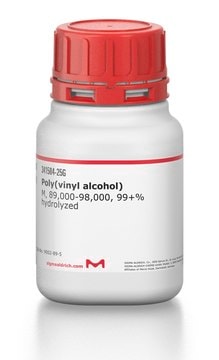If this product has an expiration or retest date, it will be shown on the Certificate of Analysis (COA, CofA). If there is no retest or expiration date listed on the product's COA, we do not have suitable stability data to determine a shelf life. For these products, the only date on the COA will be the release date; a retest, expiration, or use-by-date will not be displayed.
For all products, we recommend handling per defined conditions as printed in our product literature and website product descriptions. We recommend that products should be routinely inspected by customers to ensure they perform as expected.
For products without retest or expiration dates, our standard warranty of 1 year from the date of shipment is applicable.
For more information, please refer to the Product Dating Information document: https://www.sigmaaldrich.com/deepweb/assets/sigmaaldrich/marketing/global/documents/449/386/product-dating-information-mk.pdf
340502
Poly(ethylene-co-vinyl acetate)
vinyl acetate 40 wt. %, melt index (41-63 dg/min (190°C/2.16kg)), contains 190-910 ppm inhibitor
Synonym(s):
PEVA
About This Item
Recommended Products
form
beads
autoignition temp.
500 °F
melt index
(41-63 dg/min (190°C/2.16kg))
contains
190-910 ppm inhibitor
composition
vinyl acetate, 40 wt. %
hardness
40 (Shore A-2, ASTM D 2240)
transition temp
Tg −40-−30 °C
Tm 110-120 °C
solubility
toluene, THF, and MEK: soluble
SMILES string
C=C.CC(=O)OC=C
InChI
1S/C4H6O2.C2H4/c1-2-3-4(5)6;1-2/h2H,1,3H2,(H,5,6);1-2H2
InChI key
DQXBYHZEEUGOBF-UHFFFAOYSA-N
Looking for similar products? Visit Product Comparison Guide
Related Categories
General description
Application
- Correlation between Cohesive Energy Density, Fractional Free Volume, and Gas Transport Properties: This study explores the properties of EVA materials that affect their gas permeability, important for applications like packaging and barrier materials (Kubica & Wolinska-Grabczyk, 2015).
- The Thermal and Mechanical Properties of EVA and its Crosslinked Analogues: This research investigates how crosslinking affects the thermal and mechanical properties of EVA, which could interest material scientists working with polymers (Wang & Deng, 2019).
- Investigation of morphological, rheological, and mechanical properties of cyclic olefin copolymer/EVA blend films: This study focuses on the blend properties of EVA with other polymers, providing insights useful in academia and material science (Durmus et al., 2018).
- Fabrication, characterization, and properties of EVA/magnetite nanocomposites: Relevant to material scientists, this research discusses the incorporation of magnetite nanoparticles into EVA for enhanced properties (Ramesan, 2014).
Storage Class Code
11 - Combustible Solids
WGK
nwg
Flash Point(F)
Not applicable
Flash Point(C)
Not applicable
Personal Protective Equipment
Choose from one of the most recent versions:
Already Own This Product?
Find documentation for the products that you have recently purchased in the Document Library.
Articles
Electrospinning technique applications discussed, emphasizing control of nanofibers and assembly into 3D architectures.
Electrospinning technique applications discussed, emphasizing control of nanofibers and assembly into 3D architectures.
Electrospinning technique applications discussed, emphasizing control of nanofibers and assembly into 3D architectures.
Electrospinning technique applications discussed, emphasizing control of nanofibers and assembly into 3D architectures.
-
How can I determine the shelf life / expiration / retest date of this product?
1 answer-
Helpful?
-
-
How is shipping temperature determined? And how is it related to the product storage temperature?
1 answer-
Products may be shipped at a different temperature than the recommended long-term storage temperature. If the product quality is sensitive to short-term exposure to conditions other than the recommended long-term storage, it will be shipped on wet or dry-ice. If the product quality is NOT affected by short-term exposure to conditions other than the recommended long-term storage, it will be shipped at ambient temperature. As shipping routes are configured for minimum transit times, shipping at ambient temperature helps control shipping costs for our customers. For more information, please refer to the Storage and Transport Conditions document: https://www.sigmaaldrich.com/deepweb/assets/sigmaaldrich/marketing/global/documents/316/622/storage-transport-conditions-mk.pdf
Helpful?
-
Active Filters
Our team of scientists has experience in all areas of research including Life Science, Material Science, Chemical Synthesis, Chromatography, Analytical and many others.
Contact Technical Service


![[1R-(2-endo,3-exo)]-3-Hydroxy-4,7,7-trimethylbicyclo[2.2.1]heptane-2-acetic acid 99%](/deepweb/assets/sigmaaldrich/product/structures/302/015/ab0ad101-2636-4430-bd07-e61d744f6817/640/ab0ad101-2636-4430-bd07-e61d744f6817.png)



